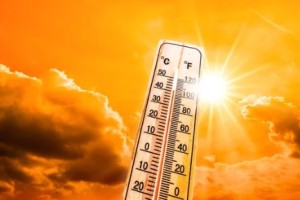Most of us have heard the old saying, “It’s not about the heat, it’s about the humidity”. In some instances, we have both. I once heard a weather forecaster refer to a 3-H Day, hazy, hot, and humid. When the temperature and the relative humidity are combined, it gives us the heat index and this tells us how hot it really feels. Extreme Heat warnings are issued whenever the heat index feels like 86 degrees F or higher. This means that people are at a increased risk for heat related illnesses or even fatalities. So, when the weather forecast says actual temperatures in the 90’s we should all use more caution with outdoor activities during those times. Some groups like seniors or young children are at even more risk. Outdoor workers are more exposed to heat and heat stress illness. as well.
According to a recent CFAES Safety and Compliance bulletin:
Heat Stress Illness includes:
Heat stroke – This is the most serious heat related effect. Heat stroke occurs when the body temperature increases above 104° F. Signs and symptoms: confusion, loss of consciousness, seizures, and lack of perspiration. This condition must be treated as a medical emergency and the employee must receive immediate medical attention.
Heat exhaustion – Signs and symptoms: headache, nausea, dizziness, weakness, irritability, confusion, thirst, heavy perspiration, and a body temperature greater than 100.4° F.
Heat cramps – Signs and symptoms: muscle pains usually caused by the loss of body salts/fluids, this can happen later as well. People should replace fluid loss by drinking water and/or carbohydrate-electrolyte liquids every 15 to 20 minutes.
Heat rash – Heat rash is caused by excessive perspiration and looks like a red cluster of pimples or small blisters.
Dehydration – Dehydration is a major factor in most heat disorders. Signs and symptoms: increasing thirst, dry mouth, weakness or light-headedness, darkening of the urine or a decrease in urination.”
Sometimes the nature of outdoor work doesn’t include shade. Tips for the pros that work outside can also apply to everyone else dealing with extreme heat. Light colored and breathable clothing; drink plenty of water about every 15 minutes drink some water; limit caffeine intake; get plenty of rest; take breaks and cool down when you can; avoid heavy, hot salty foods.
Be mindful of sun exposure as well on these hot sunny days. Reducing sunburn risk by not going out during the hottest part of the day (10am-4pm). Apply sunscreen; use lip protection; and wear sunglasses, a wide brimmed hat to protect head neck and ears, and protective clothing.
Look for low-cost cooling areas if possible. Public libraries, congregate dining centers for seniors are often climate controlled, as well as shopping malls and museums. Sometimes a little respite from the heat helps a lot. Stay hydrated! Stay safe when the heat indexes rise.
Writer: Ken Stewart, Extension Educator, Family and Consumer Sciences, Ohio State University Extension, Monroe County.
Reviewer: Lisa Barlage, Extension Educator, Family and Consumer Sciences, Ohio State University Extension, Ross County.